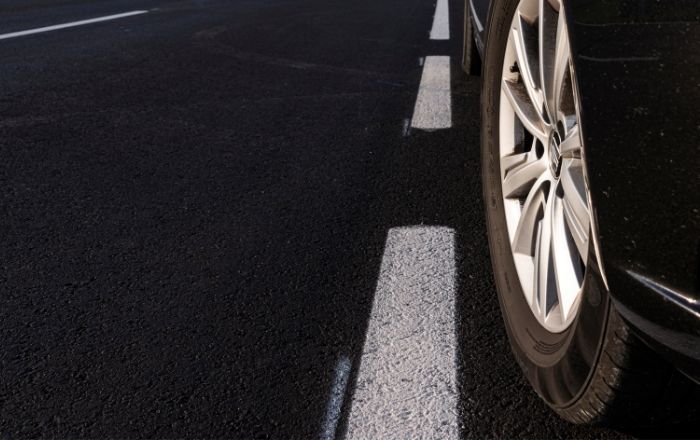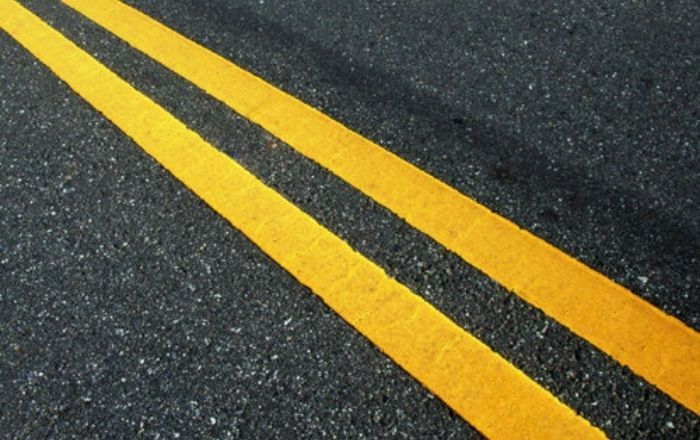MMA & THERMOPLASTIC IN PAVEMENT MARKINGS
A COMPARATIVE GUIDE FOR PAVEMENT MARKINGS
SWARCO Road Marking Systems brings both products to the streets for innovative solutions
As traffic volumes continue to rise on highways, roads, intersections, and bike lanes, the demand for durable pavement markings has grown. Traditional water-based paints, while effective for short-term solutions, often fall short in high-traffic areas due to their lack of durability. State and local agencies are turning to more resilient options to reduce the costs of frequent maintenance. Two materials that have gained popularity for pavement markings are methyl methacrylate (MMA) and thermoplastic. Both offer superior longevity and performance, but their specific characteristics make them suitable for different situations.
The Rise of MMA and Thermoplastic in Road Markings
The need for longer-lasting solutions in road markings has brought MMA and thermoplastic to the forefront. These materials have gained traction due to their ability to withstand heavy traffic, harsh weather conditions, and the daily wear and tear of road use. State and local authorities are increasingly relying on them to keep roads safer for longer periods, reducing the need for frequent reapplication and improving overall cost efficiency.
However, while both are durable, there are distinct differences in how they perform under varying conditions, making each material better suited to particular needs.

Methyl Methacrylate (MMA): A Durable and Flexible Solution
MMA has emerged as one of the most durable options for pavement markings, offering several advantages over traditional paints and even thermoplastic. MMA-based systems, like SWARCOPLAST, are designed to be highly reflective and visible in difficult conditions, such as rainy nights, making them particularly effective for enhancing road safety. The material‘s ability to divert water from pooling on the markings improves visibility in wet conditions, and when combined with reflective glass beads, it becomes an ideal solution for roads where nighttime visibility is crucial. MMA‘s longevity and flexibility make it an ideal choice for areas that require markings to last longer without frequent reapplication. It is also highly effective in settings where adverse weather conditions, such as rain and snow, demand better visibility and resistance.
Key Advantages of MMA:
- Longer Durability: MMA has a longer lifespan than thermoplastic, resisting wear in high-traffic areas, extreme weather conditions, and exposure to oils and chemicals. This leads to lower long-term maintenance costs.
- Superior Adhesion: MMA adheres well to asphalt, concrete, and other substrates, even in colder or wetter conditions where thermoplastic might struggle.
- Improved Reflectivity: Reflective beads embedded in MMA markings remain intact for longer, ensuring greater visibility, particularly at night.
- Application Flexibility: MMA can be applied in a wide range of temperatures, making it more versatile for use in various climates. Thermoplastic, by contrast, requires high temperatures for application, limiting its use in colder environments.
- Resistance to UV and Fading: MMA is more resistant to ultraviolet (UV) radiation and fading, retaining its color and visibility for longer than thermoplastic.
- Chemical Resistance: MMA coatings are highly resistant to chemical exposure, including oils and salts, commonly found on roads, helping to maintain their integrity.




Thermoplastic: The Cost-Effective Workhorse
Thermoplastic markings, such as SWARCOTHERM, are widely used due to their cost-effectiveness and long-term performance. Thermoplastics are hot-applied and made from either alkyd or hydrocarbon resins, combined with premixed reflective beads to improve visibility. One of thermoplastic‘s main advantages is its wide range of application techniques, including spray, extrude, and ribbon formulations, which allow for versatility in creating different types of road markings.
Key Advantages of Thermoplastic:
- High Reflectivity: Thermoplastics are known for their strong reflectivity, with intermix beads providing visibility throughout the life of the line. Special formulations even offer enhanced wet and night reflectivity.
- Durability: While not as long-lasting as MMA, thermoplastic can still deliver up to eight years of service life, significantly reducing maintenance costs compared to traditional paints.
- Cost-Effective Application: Thermoplastics are easier to apply in large quantities and can be laid down faster than MMA, making them a cost-effective option for projects where speed and budget are critical factors.
- Environmental Benefits: Like MMA, thermoplastic materials are solvent-free and have a solid content of 100%, making them a more environmentally friendly option compared to traditional paint systems.
Choosing Between MMA and Thermoplastic
While MMA is often considered superior in terms of durability, adhesion, and reflectivity, thermoplastic remains a popular choice for certain applications due to its lower initial cost and ease of application. Thermoplastic is favored in warmer climates, where its need for high temperatures during application is not an issue, and in areas where budgets and reapplication schedules are less stringent.
For projects requiring long-term durability in high-traffic areas with challenging weather conditions, MMA is generally the better choice. Its resistance to chemicals, UV rays, and moisture, combined with superior reflectivity, makes it ideal for places where safety is paramount. On the other hand, thermoplastic is a suitable choice for agencies looking for a cost-effective solution that can be applied quickly, offering sufficient durability and visibility in less demanding environments.
